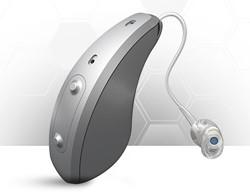
The California-based Earlens Corporation has developed an incredible new type of hearing aid that uses light, of all things, to enhance hearing. The Earlens Hearing Aid is like a contact lens for the ear, attaching directly to the eardrum through surface tension – the same way a contact lens adheres to the eye. The device consists of three parts: a photon processor, a light tip, and a custom-fitted lens, which is placed in the ear by an ear, nose and throat specialist. The photon processor, which rests behind the ear, transmits sound waves to the light tip, which converts the sound into non-visible light. The light, in turn, signals the lens to activate the wearer’s natural hearing system.
It sounds unbelievable, but it works. According to Earlens, the device delivers a broader range of sound frequency than any other hearing aid on the market. To get a visual of how it works, check out the video below:
Earlens will be implementing the Solumina MES software in their Menlo Park headquarters to help them manage production, quality control and cost efficiency.
“We are excited to work with iBASEt to put in place an innovative technology manufacturing infrastructure,” said Mark Bishop, VP of Operations of Earlens. “We believe it is a smart move for us to implement an MES/QMS solution now, in the early stages of our business, so that we can rapidly scale production to meet growing demand for our product and keep pace with design changes and improvements.”
“Additive manufacturing, using 3D printing technology, is a fundamentally new approach that offers manufacturers a number of advantages over traditional methods for better design flexibility, time to market and cost control,” said Vic Sial, President of iBASEt. “We appreciate the confidence Earlens has placed in iBASEt by choosing our software and team of experts to put in place the innovative manufacturing infrastructure the company needs to manage production, streamline operations and meet changing design and regulatory requirements.”
What are your thoughts on this new device? Discuss further in the 3D Printed Hearing Aid forum over at 3DPB.com.